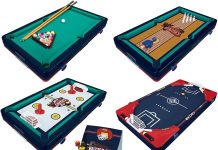Let’s talk about the age-old question that has been on the minds of parents and guardians everywhere: is air hockey safe for kids to play?
As children’s safety is our top priority, it is crucial to consider this popular game’s potential risks and benefits.
Join us as we explore the intricate world of air hockey and uncover the potential hazards and precautions necessary for ensuring a fun and safe experience for our little ones.
Review contents
Physical Safety
Equipment Safety
When it comes to ensuring children’s physical safety, paying attention to the safety of the equipment involved in the game is essential. Air hockey tables typically have a smooth playing surface and require a puck and mallets. It’s essential to ensure that the table is sturdy and in good condition, with no sharp edges or loose parts that could pose a risk of injury. Additionally, it’s essential to check the mallets and puck for any damage or wear and tear and replace them if necessary. By ensuring that the equipment is safe to use, we can minimize the chances of any accidents occurring.
Physical Injuries
While air hockey is generally considered a safe game, like any physical activity, there is always a risk of physical injuries. Common injuries associated with air hockey include minor bruises or scratches from accidental collisions between players or the mallet hitting the puck. However, serious injuries are rare. To minimize the risk of physical injuries, it’s essential to establish clear guidelines for playing and encourage responsible behavior on the table. It’s also essential for children to understand the importance of respecting personal space and being mindful of their movements while playing.
Supervision
Proper supervision during air hockey play is crucial to ensure the safety of children. As responsible adults, we must provide adequate supervision and guidance while children are engaged in the game. This includes monitoring their behavior, ensuring fair play, and intervening to prevent unsafe situations. By actively participating in their playtime, we can promote a safe and enjoyable experience for children.
Cognitive Development
Hand-Eye Coordination
Playing air hockey requires quick reflexes and hand-eye coordination. The game demands players to track the puck’s movement, anticipate its path, and skillfully strike it with the mallet. Through regular play, children can develop and improve their hand-eye coordination, an essential cognitive skill for various other activities, such as playing other sports or musical instruments.
Reaction Time
Air hockey is a fast-paced game that requires players to make split-second decisions and react promptly. By playing air hockey, children can enhance their reaction time, as they need to be alert and responsive to the movements of the puck and their opponent. This can positively affect their cognitive development, as quick thinking and rapid responses are valuable skills in many aspects of life.
Strategy and Planning
Air hockey is a game of speed and reflexes, strategy and planning. Players must anticipate their opponent’s moves, create opportunities to score, and devise effective defensive tactics. Through the game, children can develop their strategic thinking and planning abilities, enhancing their cognitive skills in problem-solving, critical thinking, and decision-making.
Social Skills
Sportsmanship
Playing air hockey provides an excellent opportunity for children to learn and practice good sportsmanship. By participating in a competitive yet friendly game, children can learn to respect their opponents, accept victory or defeat gracefully, and follow the rules of fair play. These lessons in sportsmanship can be carried over into other areas of their lives, helping them develop social skills and fostering positive relationships with others.
Teamwork
While air hockey is typically played one-on-one, it can still teach children the importance of teamwork. Even in individual games, players often engage in friendly banter, offer encouragement to their opponents, and celebrate each other’s successes. By playing air hockey, children can understand the value of collaboration, cooperation, and supporting each other, essential skills for success in team-based activities later in life.
Communication
Air hockey can also improve children’s communication skills. During the game, players need to communicate with their opponents, whether it’s through friendly chatter, discussing scores, or making playful challenges. This interaction helps children develop their ability to express themselves effectively, listen to others, and engage in healthy communication. These communication skills are valuable in sports, personal relationships, and future professional endeavors.
Physical Fitness
Physical Activity
One of the apparent benefits of playing air hockey is the physical activity it involves. While it may not be as physically demanding as some other sports or vigorous activities, air hockey still requires players to move, react, and engage their muscles. Regular play can improve overall physical fitness and help children meet the recommended daily physical activity levels.
Exercise Benefits
Engaging in physical activity, such as playing air hockey, provides numerous health benefits for children. It promotes cardiovascular fitness, strengthens muscles, improves flexibility, and enhances motor skills. By incorporating air hockey into their routine, children can enjoy these exercise benefits while having fun and staying active.
Health Aspect
Air hockey can be a great way to introduce children to a healthier lifestyle. By actively participating in the game, children become more aware of their physical well-being and the importance of staying fit. It can encourage them to adopt healthier habits like regular exercise, balanced diets, and an active lifestyle. Teaching children to prioritize their health through activities like air hockey can have long-lasting positive effects on their overall well-being.
Mental Stimulation
Concentration
Playing air hockey requires a high level of concentration and focus. With the game’s fast-paced nature, players must stay engaged and pay close attention to the puck’s movement and their opponent’s actions. Regularly engaging in air hockey can improve children’s ability to concentrate, enhancing their attention span and allowing them to maintain focus in various other aspects of their lives, including academics.
Problem-Solving
Air hockey presents players with constant challenges and the need to think critically to outsmart their opponents. Children can enhance their problem-solving skills by analyzing their opponent’s moves and strategizing their own. They learn to think logically, anticipate outcomes, and make quick decisions under pressure. These problem-solving abilities developed through air hockey can be applied to various other areas of their lives, enabling them to tackle challenges effectively.
Improving Attention Span
The fast-paced nature of air hockey trains children’s brains to process information quickly and efficiently. By continuously monitoring the puck’s movement and anticipating its actions, children can improve their attention span, becoming better able to sustain focus and concentrate for extended periods.
This increased attention span can benefit them in various aspects of their daily lives, such as studying, completing tasks, and engaging in other activities requiring sustained attention.

Risk Factors
Age Appropriateness
While people of all ages can enjoy air hockey, it is essential to consider the age appropriateness of the game for children. Younger children may struggle to keep up with the rapid movements and coordination required for air hockey. It is essential to assess a child’s physical and cognitive abilities before allowing them to engage in the game, ensuring that they are developmentally ready to participate safely and enjoyably.
Game Environment
The environment in which air hockey is played can also affect the safety and experience of children. Ensuring that the playing area is free of hazards, with sufficient space around the table, can prevent accidents and injuries. Keeping the area well-lit and ventilated can also give children a more comfortable and enjoyable gaming experience.
Playing Techniques
Teaching children the proper techniques and rules of air hockey is essential to minimize the risk of injuries. Educating them about striking the puck with the mallet, maintaining good posture, and avoiding aggressive moves can help prevent accidents. Encouraging fair play and discouraging rough and reckless behavior further reduces the risk of injuries during the game.
Preventing Injuries
Proper Use of Equipment
Educating children on the proper use of air hockey equipment is crucial to prevent injuries. Teaching them how to hold the mallet correctly, strike the puck safely, and avoid hitting each other with the mallet can significantly reduce the risk of accidents. Additionally, emphasizing the importance of not leaning or placing excessive weight on the air hockey table can prevent falls and injuries.
Supervision and Guidance
Active supervision and guidance from responsible adults are vital in preventing injuries during air hockey play. Adults should be present to enforce safety guidelines, monitor children’s behavior, and intervene promptly if any unsafe situations arise. By actively supervising the game, adults can prevent accidents, address unsafe practices, and provide guidance to ensure children’s safe and enjoyable experiences.
Educating Kids about Safety
It is essential to educate children about safety measures specific to air hockey. This includes explaining the risks, teaching them how to respond to accidents or injuries, and encouraging them to look out for their safety and the safety of others. By fostering a culture of safety awareness, children can understand the importance of taking precautions and making responsible choices while enjoying the game.
Alternatives to Consider
Indoor Board Games
For parents or guardians concerned about air hockey’s physicality, an alternative to consider is indoor board games. Board games offer a variety of cognitive benefits and can be enjoyed by children of different ages. From classic options like Chess and Scrabble to more modern choices like Settlers of Catan and Ticket to Ride, numerous options suit different interests and developmental needs.
Noncontact Sports
Noncontact sports can be a great alternative to air hockey if the goal is to promote physical activity and fitness while minimizing the risk of injuries. Sports such as swimming, gymnastics, or individual athletics like track and field events can offer a safe and enjoyable way for children to stay active, develop their skills, and build their physical fitness levels.
Other Tabletop Games
In addition to air hockey, various tabletop games can provide similar cognitive benefits and entertainment value. Games like foosball, ping pong, and billiards offer opportunities for physical activity and strategic thinking while minimizing the potential for injuries. These games can be enjoyed by children and adults alike, making them a versatile option for family fun.

Expert Opinions
Pediatricians
Pediatricians generally agree that air hockey can be a safe and enjoyable game for children when appropriate safety measures are in place. They emphasize the importance of proper supervision and maintaining age-appropriate play environments. Pediatricians also highlight the cognitive and physical benefits that air hockey can provide, such as enhanced hand-eye coordination, critical thinking skills, and physical activity.
Child Psychologists
Child Psychologists view air hockey as a positive activity contributing to children’s cognitive, social, and physical development. They emphasize the benefits of playing games that require strategy, problem-solving, and communication. Child Psychologists also suggest that the competitive nature of air hockey can teach children valuable life skills, such as resilience, self-control, and sportsmanship.
Physical Education Specialists
Physical Education specialists recognize the value of air hockey as a recreational activity that promotes physical fitness and cognitive development. They endorse air hockey as a low-impact game that can improve hand-eye coordination, reaction time, and concentration. Physical Education specialists emphasize the need for appropriate safety measures and responsible play to minimize the risk of injuries and promote a positive gaming experience.
Conclusion
In conclusion, air hockey can be a safe and beneficial game for children when proper safety measures are in place. It offers a range of physical, cognitive, and social benefits, promoting hand-eye coordination, reaction time, strategic thinking, teamwork, and communication skills.
However, ensuring age-appropriate play, providing adequate supervision, and educating children about safety guidelines is crucial. By considering alternatives and seeking expert opinions, parents and guardians can make informed decisions about incorporating air hockey into their children’s recreational activities. With the proper precautions, air hockey can offer an enjoyable and enriching experience for kids of different ages and skill levels.























![Best Outdoor Dartboards [Reviews and Buying Guide 2024] Best Outdoor Dartboards](https://gamersets.com/wp-content/uploads/2022/12/Best-Outdoor-Dartboards-100x70.jpg)

![Best Mini Air Hockey Table [Reviews & Buying Guide 2024] Best mini air hockey table](https://gamersets.com/wp-content/uploads/2022/10/Best-mini-air-hockey-table-100x70.jpg)







